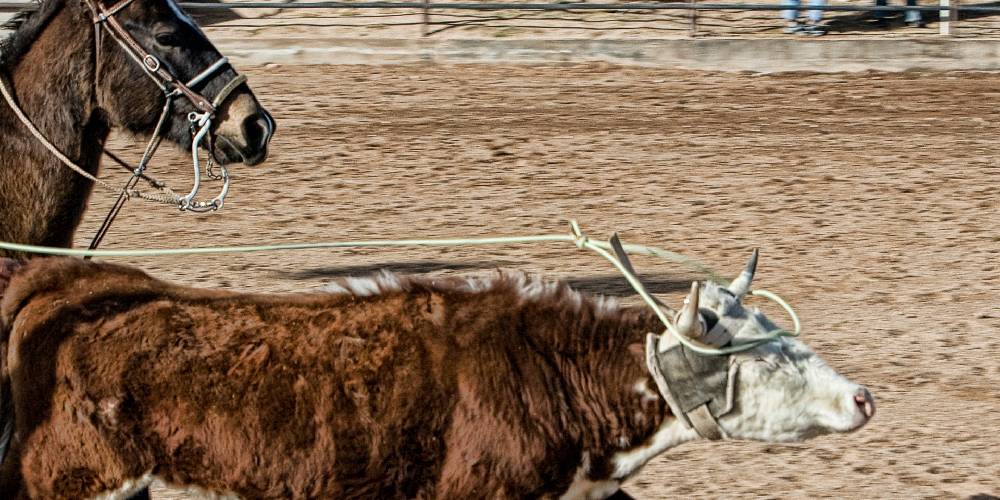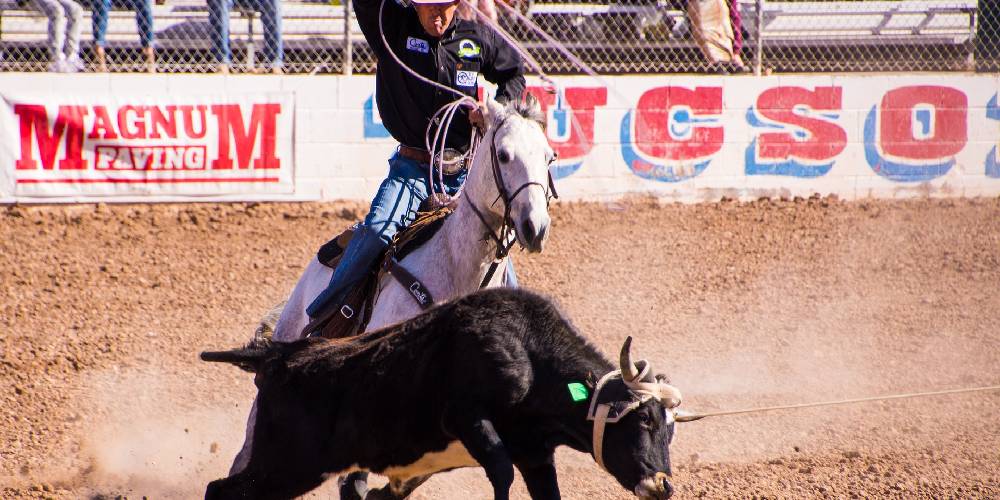Roping is one of those sports that started off where it was actually needed for working on farms, ranches, and cattle drives all across America. Though it is still used on ranches and farms today, roping has turned mainly into a sport with various levels of competition.
What Is Roping?
Roping is a western sport in horseback riding where a rider must chase a cow on horseback, rope the cow with a lasso, and dally the rope around their saddle horn to stop the cow. Some roping events require the rider to get off the horse and tie up the cow. The horses used for roping are highly trained in this discipline and know how to work with cattle. Roping is a timed event and the fastest roper or team of ropers to get their job done wins. This sport is seen using mainly Quarter Horses as they are strong, have great cow sense, and are fast.
Where Did Roping Originate?

Roping originated before the Wild West days mainly in South western America and parts of Mexico. The technique and skill was really handy on cattle ranches when cattle needed to be caught, branded, or required medical attention.
These skills were used throughout the Wild West days from the year of 1607 to the year 1920. From there on out, the skills began to be mainly used for sport rather than work as the number of cowboys and cattle ranches dropped. Today, people still use roping on ranches for the same purposes as hundreds of years ago, but it is seen less and less common for work, and more and more common for sport.
What Is Expected Of The Horse?
In roping, no matter what kind of roping, the horse must be desensitized to the sound of a rope swinging over their head. The horse must be cow smart and know to follow the cow at a safe distance where the roper can still get the cow.
There are actually two types of roping: Team roping and calf roping. There are two different expectations for horses when it comes to team roping versus calf roping.
In calf roping, there is only one horse competing. The horse is expected to chase the cow and not react to the swinging rope. The horse must stop once the calf is roped and keep the rope tight for the rider while the rider dismounts and goes to the cow.
In team roping, there are two horses involved. One of them should be on either side of the cow and both will be running behind the cow at a reasonable distance. Once the rider ropes the cow, the horse must stop and keep the rope tight while still holding the rider.
Do Roping Horses Like Their Job?

Some roping horses absolutely love their jobs. Some horses are known as ‘cow savvy’ which basically means cow smart. They know how to herd and guide the cow where they want them to go. Having a horse that is cow savvy shows that the horse likes their job and likes working with the cattle.
Is Roping Dangerous?
Yes. Like many riding disciplines, roping is a dangerous sport. There are horror stories of horses getting cut by the rope, riders getting their fingers caught and ripped off by the rope, and cows breaking bones.
Though it is unlikely that you would get hurt because of the horse, it is not unheard of and having a horse spook at the rope is not uncommon. This is why it is essential to have your horse completely trained and broke.
When roping, make sure that you are riding a trained roping horse, you don’t get your fingers caught in the rope, and that your saddle is meant for roping.
Different Types Of Roping

like I mentioned before, there are two different types of roping: Team roping and calf roping. They have so many differences though they still fall into the roping category.
Team Roping
Team roping is a sport that involves two riders, two horses, and one cow. The way that team roping works is that two horses and riders stand on either side of a chute. When the chute opens, the cow is set loose. At this point, both horses will run and chase after the cow.
The first person to rope the cow is called a header. They are responsible for roping the cows horns. Headers are most commonly working on the left side of the cow. Once they have the horns roped, they then dally the rope around their saddle horns, then it is the next person’s turn.
The next person to rope the cow is called a heeler. The heeler is responsible for getting their rope under the cow’s back legs when they lift them up to run. the heeler is usually on the right side of the cow and ropes the cows hind legs once the header’s rope is securely set on the horns.
Team roping is a timed event where the fastest and most accurate roping team to get the cow roped and down wins.
Calf Roping
Calf roping is a solo rider event where a baby cow or calf is let out of a chute and a single horse and rider will rope it. Because calves don’t have horns, the rider must rope the calves’ neck.
Once the calf has been roped on the neck, the horse will then keep the rope tight and the rider will jump off the horse and lie on the calf. They then must tie together three of their legs and remount their horse. The calf must remain tied for six seconds in order to get a time.
The fastest roper who’s calf remains tied wins the event.
Roping Penalties

Team Roping
Penalties are offered in roping for a variety of reasons. Some examples of times where penalties would be offered include: only catching one leg, or letting the cow get too far away before roping them.
If the heeler only catches one hind leg, five seconds are added to the team’s time. If the header and heeler let the cow get too far and pass a certain point, then there are ten seconds added to the team’s overall time.
Calf Roping
Like in team roping, there are some penalties that can be added. The main one is letting the calf get too far away, but there is also the fact that a roper can be eliminated if the calf doesn’t stay tied down for the full six seconds.
How Is Roping Judged?

Roping is a time based sport. The fastest and most accurate roper wins the event. In roping, the team or single roper must rope the cow or calf before they reach the barrier.
How Old Should A Horse Be Before It Starts Roping?
Horses can start roping around the age of three or four. The way you know if your young horse is ready to start roping is if they aren’t scared of the rope, they follow the cow, and they pull the rope tight once a cow has been roped.
How Long Does It Take To Train A Roping Horse?
It can take several years to train a roping horse to a professional level. For an average practice roping horse or ranch horse, it can begin to be used after several months of training. A professional horse may require up to three years of practice and experience to reach that level.
What Do Riders In This Sport Wear?

Hat
Like many other western disciplines, cowboy hats are a popular accessory for riders in this field. These hats can most commonly be seen in white, black, or tan.
Button Up Shirt
A button up shirt is a common shirt to wear when roping at the professional level. It makes a rider look more professional.
Jeans
Boot-cut jeans are actually one of the only pairs of pants worn by riders in this area. They are durable and comfortable pants to ride in making them very popular.
Boots
Cowboy boots are the shoe of choice by ropers. They can have a pointed, rounded, or square toe and have a riding heel as opposed to a walking heel seen on other boots.
Spurs
Spurs can be worn on roping horses to help the rider get their horse moving faster. They go on the boot behind the rider’s ankle and above their heel.
Gloves
Handling a rope can be hard on the hands so roping gloves are sometimes worn to help protect the rider’s hands from rope burn and wear and tear.
What Tack Is Used On Roping Horses?

Leg Wraps
Leg wraps are used on roping horses to help support their legs when running and pulling back to keep the rope tight. Wraps keep the legs safe from any potential injury that may occur.
Roping Saddle
Roping saddles are the only saddles that should be used when roping. This is because they are built with a much stronger and sturdier horn and pommel than other saddles to withstand the strain put on them by the rope when it is dallied around the horn.
Saddle Pad
A decently padded saddle pad should be used when roping to keep the horse from getting rubbed by or sore from their saddle.
Breast Collar
Breast collars are a good accessory to have wehn roping becasue it helps keep the saddle more secure on the horse when a cow is pulling on the saddle
Bridle
A bridle is used in this discipline in the western style. Th bit used in these horse’s mouths isn’t usually very harsh.
Back Cinch
A back cinch is a must have for roping to help keep thesaddle from popping forward when going under strain and being pulled on by the cow.
Breeds That Excel In This Discipline
- Quarter Horses
- Mustangs
- Paint Horses
- Missouri Fox Trotters

